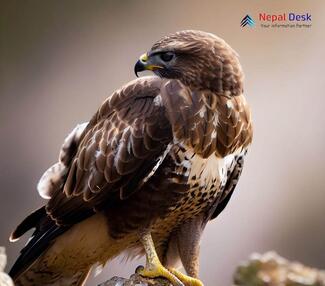Nepal is a treasure trove of diverse flora and fauna. The country's rich biodiversity has something to offer for every nature enthusiast. One such captivating species that can often be spotted in the skies above Nepal is the Common Buzzard (Buteo buteo). It is a widespread medium-to-large bird of prey and belongs to the family Accipitridae, within the genus Buteo. With its global population in the millions, it seems to be the most prevalent diurnal raptor in Europe. First officially described by Swedish naturalist Carl Linnaeus in 1758's tenth edition of Systema Naturae, it was referred to as Falco buteo. The term "buteo" comes from Latin, meaning buzzard. It is essential not to confuse the common buzzard with the turkey vulture, which is occasionally called a buzzard in American English. Let us look at its more aspects below under various topics:
A Closer Glimpse at the Common Buzzard
The Common Buzzard is a medium-sized raptor with a robust build and an impressive wingspan of up to 120 centimeters. It is characterized by its broad wings, relatively short tail, and distinctive mottling patterns on its plumage. These birds boast a remarkable adaptability, residing in habitats ranging from forests and grasslands to marshes and even urban areas.
In Nepal, you may have the privilege of spotting these incredible birds soaring gracefully through the sky or perching on prominent vantage points, scanning their surroundings for potential prey. The diet of a Common Buzzard mainly consists of small mammals like voles and rabbits, as well as birds, reptiles, and insects.
The Role of the Common Buzzard in Nepal's Ecosystem
As predators who sit near the top of the food chain, Common Buzzards play an essential role in maintaining the delicate balance of their ecosystem. Feeding on small mammals and other creatures, they help control population numbers and prevent overpopulation or uncontrolled outbreaks. They are also natural scavengers, keeping environments clean by feasting on carrion.
Conservation Efforts and Opportunities for Wildlife Enthusiasts
Despite facing various threats such as habitat loss, pesticides, and illegal hunting, the Common Buzzard has maintained a stable population size overall. In Nepal, ongoing conservation efforts include habitat protection, public education, and anti-poaching initiatives.
For those interested in witnessing the majesty of the Common Buzzard in person, Nepal offers numerous birdwatching and wildlife tours that cater to enthusiasts of all experience levels. You may even have the chance to spot other fascinating birds of prey, such as the Mountain Hawk Eagle, the Black Kite, or the majestic Golden Eagle.
In conclusion, the Common Buzzard is a striking example of Nepal's rich avian biodiversity. By continuing our efforts to protect and conserve their habitats, we can ensure that these magnificent raptors continue to grace our skies for generations to come. So next time you find yourself exploring Nepal's diverse landscapes, don't forget to look up and admire these awe-inspiring birds as they soar on the winds high above you.




